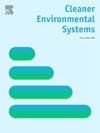A comprehensive analysis of process-related CO2 emissions from Iran's cement industry
IF 4.9
Q2 ENGINEERING, ENVIRONMENTAL
引用次数: 0
Abstract
Direct emissions from the cement industry account for 7%–8% of global anthropogenic CO₂ emissions, primarily from thermal decomposition of carbonates (i.e., calcination) during clinker production. Iran ranks among the world's top ten cement producers and is the seventh-largest CO₂ emitter globally. Despite its significant contribution to global emissions, Iran's process-related CO2 emissions (i.e., chemically derived CO2 from calcination) remain underreported in international datasets. This study addresses this gap by analyzing CO₂ emissions from carbonate decomposition in 77 Iranian cement plants from 2013 to 2023, highlighting regional and plant-specific emission factors. Utilizing plant-specific clinker data, the study applied methodologies aligned with the 2006 IPCC Guidelines and the WRI/WBCSD Greenhouse Gas Protocol to calculate emission factors and CO2 emissions. The findings show notable geographical variations and a substantial national trend, with emissions rising from 28.75 million tonnes (Mt) in 2016 to 39.33 Mt in 2023. A primary contributor is Iran's high clinker-to-cement ratio, averaging 94.1% in 2023, underscoring the urgent need for sustainable production practices, particularly through the adoption of supplementary cementitious materials (SCMs) like pozzolans and industrial by-products. To address this, the study recommends a two-pronged policy approach: reducing clinker content in cement by promoting blended alternatives, such as Portland Composite Cement (PCC) and Portland Pozzolana Cement (PPC), through regulatory controls and economic incentives. These results emphasize the importance of targeted, data-driven policies for sustainable cement production, offering critical insights for stakeholders and policymakers aiming to align Iran's cement sector with global emissions reduction goals.
伊朗水泥工业过程相关二氧化碳排放的综合分析
水泥工业的直接排放量占全球人为二氧化碳排放量的7%-8%,主要来自熟料生产过程中碳酸盐的热分解(即煅烧)。伊朗是世界十大水泥生产国之一,也是全球第七大二氧化碳排放国。尽管伊朗对全球排放做出了重大贡献,但在国际数据集中,伊朗与过程相关的二氧化碳排放(即从煅烧中化学衍生的二氧化碳)仍然被低估。本研究通过分析2013年至2023年伊朗77家水泥厂碳酸盐分解产生的二氧化碳排放量来解决这一差距,突出了区域和工厂特定的排放因素。利用特定工厂的熟料数据,该研究采用了与2006年IPCC指南和世界资源研究所/世界生物多样性委员会温室气体议定书相一致的方法来计算排放因子和二氧化碳排放量。研究结果显示出显著的地理差异和显著的国家趋势,排放量从2016年的2875万吨上升到2023年的3933万吨。主要原因是伊朗的熟料与水泥比例很高,到2023年平均为94.1%,这凸显了对可持续生产实践的迫切需求,特别是通过采用火山灰和工业副产品等补充胶凝材料(SCMs)。为了解决这个问题,该研究建议采取双管齐下的政策方法:通过监管控制和经济激励,促进波特兰复合水泥(PCC)和波特兰波佐拉那水泥(PPC)等混合替代品,减少水泥中的熟料含量。这些结果强调了有针对性的、数据驱动的政策对可持续水泥生产的重要性,为旨在使伊朗水泥行业与全球减排目标保持一致的利益相关者和政策制定者提供了重要见解。
本文章由计算机程序翻译,如有差异,请以英文原文为准。
求助全文
约1分钟内获得全文
求助全文
来源期刊

Cleaner Environmental Systems
Environmental Science-Environmental Science (miscellaneous)
CiteScore
7.80
自引率
0.00%
发文量
32
审稿时长
52 days
 求助内容:
求助内容: 应助结果提醒方式:
应助结果提醒方式:


